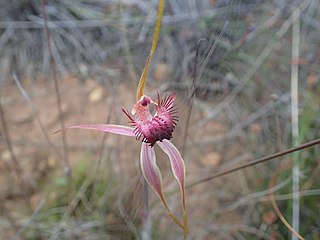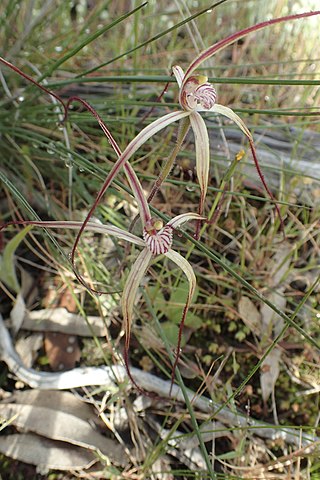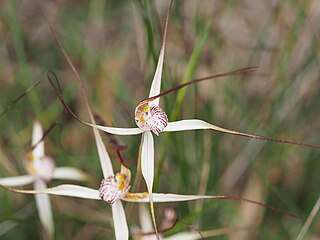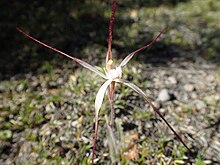
Caladenia cruscula, commonly known as the reclining spider orchid is a species of orchid endemic to a small area in the south-west of Western Australia. It has a single hairy leaf and a single cream-coloured flower with a long red fringe on the sides of its labellum.

Caladenia decora, commonly known as the Esperance king spider orchid is a species of orchid endemic to the south-west of Western Australia. It has a single hairy leaf and up to three red, yellow and green flowers. It is a variable species, similar to the king spider orchid and sometimes hybridises with other species so that it can be difficult to recognise, but is one of the largest spider orchids found in Western Australia.

Caladenia denticulata subsp. denticulata, commonly known as the yellow spider orchid, is a plant in the orchid family Orchidaceae and is endemic to the south-west of Western Australia. It has a single erect, hairy leaf and one or two yellowish flowers which have a white labellum with pale red markings.
Caladenia denticulata subsp. rubella, commonly known as the clumped spider orchid, is a plant in the orchid family Orchidaceae and is endemic to the south-west of Western Australia. It has a single erect, hairy leaf and one or two dull or pinkish red flowers with prominent dull red markings and with a white labellum with red markings.
Caladenia drakeoides, commonly known as the hinged dragon orchid is a species of orchid endemic to the south-west of Western Australia. It has a single hairy leaf and a single greenish-yellow and red flower with a hinged labellum resembling a female thynnid wasp.

Caladenia erythronema, commonly known as the red thread spider orchid, and Nyabing spider orchid is a plant in the orchid family Orchidaceae and is endemic to the south-west of Western Australia. It has a single hairy leaf and up to three red, yellow or cream-coloured flowers with dangling, thread-like sepals and petals and a small labellum.

Caladenia fluvialis, commonly known as the Brookton Highway spider orchid is a species of orchid endemic to the south-west of Western Australia. It is a recently discovered orchid with a single hairy leaf and one or two cream-yellow flowers with red markings on the labellum.

Caladenia horistes, commonly known as the cream spider orchid is a species of orchid endemic to the south-west of Western Australia. It has a single, hairy leaf and one or two, creamy-yellow flowers which have a red-striped labellum and long, dark, thread-like tips on the sepals and petals.
Caladenia perangusta, commonly known as the Boyup Brook spider orchid, is a species of orchid endemic to the south-west of Western Australia. It is a rare spider orchid with a single hairy leaf and one or two cream-yellow or red flowers with narrow, drooping sepals and petals.
Caladenia pluvialis, commonly known as the Yuna spider orchid, is a species of orchid endemic to the south-west of Western Australia. It is a common spider orchid, especially after winter rains, occurring in a restricted area. It has a single hairy leaf and one or two creamy-coloured flowers. It was formerly included with Caladenia incensa.

Caladenia polychroma, commonly known as the Joseph's spider orchid, is a species of orchid endemic to the south-west of Western Australia. It has a single erect, hairy leaf and one or two relatively large and colourful but smelly flowers.

Caladenia remota subsp. parva, commonly known as the Perenjori spider orchid, is a plant in the orchid family Orchidaceae and is endemic to the south-west of Western Australia. It has a single hairy leaf and up to three creamy-white to pale yellow flowers. It has a more restricted and more westerly distribution than subspecies remota.
Caladenia petrensis, commonly known as the rock spider orchid is a plant in the orchid family Orchidaceae and is endemic to the south-west of Western Australia. It has a single erect, hairy leaf and up to three pale yellow flowers with drooping lateral sepals and petals.
Caladenia saxicola, commonly known as the banded ironstone spider orchid is a plant in the orchid family Orchidaceae and is endemic to the south-west of Western Australia. It has a single erect, hairy leaf and one or two dull creamy-white to pale yellow flowers with spreading lateral sepals and petals.

Caladenia straminichila, commonly known as the Tenterden yellow spider orchid, is a species of orchid endemic to the south-west of Western Australia. It has a single erect, hairy leaf and one or two pale yellow flowers which have a red-striped labellum with short teeth on its sides.

Caladenia xantha, commonly known as the primrose spider orchid, is a species of orchid endemic to the south-west of Western Australia. It has a single erect, hairy leaf and up to three yellow flowers with a cream-coloured, brown-striped labellum.

Caladenia exilis is a species of flowering plant in the orchid family Orchidaceae and is endemic to the south-west of Western Australia. It is a ground orchid with a single erect, linear leaf and up to three white to greenish-cream or dark pinkish-maroon flowers.

Caladenia hirta, commonly known as sugar candy orchid, flowering plant in the orchid family Orchidaceae and endemic to the south-west of Western Australia. It is a ground orchid with a single broad, hairy leaf and up to six white or pink and white flowers with pink markings.
Caladenia nana, commonly known as pink fan orchid, is a plant in the orchid family Orchidaceae and is endemic to the south-west of Western Australia. It is a clump-forming ground orchid with a single linear leaf and up to 6 pale pink to rose pink flowers.

Caladenia pendens is a species of flowering plant in the orchid family and is endemic to the south-west of Western Australia. It has a single erect, linear leaf and up to three cream-coloured to dark pinkish-maroon flowers with reddish-purple markings.















